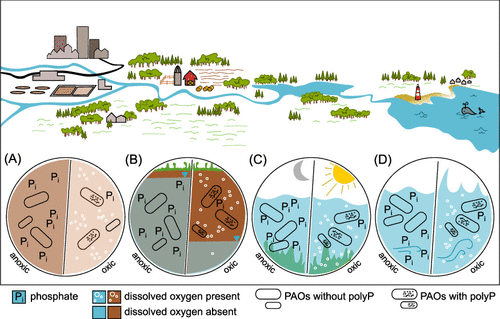当前位置:
X-MOL 学术
›
Environ. Sci. Technol.
›
论文详情
Our official English website, www.x-mol.net, welcomes your
feedback! (Note: you will need to create a separate account there.)
Critical Review of Polyphosphate and Polyphosphate Accumulating Organisms for Agricultural Water Quality Management
Environmental Science & Technology ( IF 10.8 ) Pub Date : 2021-02-09 , DOI: 10.1021/acs.est.0c03566 Sheila M. Saia 1 , Hunter J. Carrick 2 , Anthony R. Buda 3 , John M. Regan 4 , M. Todd Walter 5
Environmental Science & Technology ( IF 10.8 ) Pub Date : 2021-02-09 , DOI: 10.1021/acs.est.0c03566 Sheila M. Saia 1 , Hunter J. Carrick 2 , Anthony R. Buda 3 , John M. Regan 4 , M. Todd Walter 5
Affiliation

|
Despite ongoing management efforts, phosphorus (P) loading from agricultural landscapes continues to impair water quality. Wastewater treatment research has enhanced our knowledge of microbial mechanisms influencing P cycling, especially regarding microbes known as polyphosphate accumulating organisms (PAOs) that store P as polyphosphate (polyP) under oxic conditions and release P under anoxic conditions. However, there is limited application of PAO research to reduce agricultural P loading and improve water quality. Herein, we conducted a meta-analysis to identify articles in Web of Science on polyP and its use by PAOs across five disciplines (i.e., wastewater treatment, terrestrial, freshwater, marine, and agriculture). We also summarized research that provides preliminary support for PAO-mediated P cycling in natural habitats. Terrestrial, freshwater, marine, and agriculture disciplines had fewer polyP and PAO articles compared to wastewater treatment, with agriculture consistently having the least. Most meta-analysis articles did not overlap disciplines. We found preliminary support for PAOs in natural habitats and identified several knowledge gaps and research opportunities. There is an urgent need for interdisciplinary research linking PAOs, polyP, and oxygen availability with existing knowledge of P forms and cycling mechanisms in natural and agricultural environments to improve agricultural P management strategies and achieve water quality goals.
中文翻译:

农业水质管理中多磷酸盐和多磷酸盐蓄积生物的评论。
尽管进行了不断的管理,但是农业景观中的磷(P)仍在损害水质。废水处理研究提高了我们对影响P循环的微生物机制的了解,特别是关于称为多磷酸盐累积生物(PAO)的微生物,该微生物在有氧条件下将P储存为多磷酸盐(polyP),在无氧条件下释放P。但是,PAO研究在减少农业磷负荷和改善水质方面的应用有限。在本文中,我们进行了荟萃分析,以确定Web of Science上有关polyP的文章以及PAO在五个学科(即废水处理,陆地,淡水,海洋和农业)中的使用情况。我们还总结了为自然环境中的PAO介导的P循环提供初步支持的研究。地面的 与废水处理相比,淡水,海洋和农业学科的polyP和PAO文章较少,而农业始终是最少的。大多数荟萃分析文章没有重叠的学科。我们找到了对自然栖息地中的PAO的初步支持,并确定了一些知识空白和研究机会。迫切需要跨学科的研究,将PAO,polyP和氧气的可用性与天然和农业环境中现有的P形态和循环机制的知识联系起来,以改善农业P的管理策略并实现水质目标。我们找到了对自然栖息地中的PAO的初步支持,并确定了一些知识空白和研究机会。迫切需要跨学科的研究,将PAO,polyP和氧气的可用性与天然和农业环境中现有的P形态和循环机制的知识联系起来,以改善农业P的管理策略并实现水质目标。我们找到了对自然栖息地中的PAO的初步支持,并确定了一些知识空白和研究机会。迫切需要跨学科的研究,将PAO,polyP和氧气的可用性与天然和农业环境中现有的P形态和循环机制的知识联系起来,以改善农业P的管理策略并实现水质目标。
更新日期:2021-03-02
中文翻译:

农业水质管理中多磷酸盐和多磷酸盐蓄积生物的评论。
尽管进行了不断的管理,但是农业景观中的磷(P)仍在损害水质。废水处理研究提高了我们对影响P循环的微生物机制的了解,特别是关于称为多磷酸盐累积生物(PAO)的微生物,该微生物在有氧条件下将P储存为多磷酸盐(polyP),在无氧条件下释放P。但是,PAO研究在减少农业磷负荷和改善水质方面的应用有限。在本文中,我们进行了荟萃分析,以确定Web of Science上有关polyP的文章以及PAO在五个学科(即废水处理,陆地,淡水,海洋和农业)中的使用情况。我们还总结了为自然环境中的PAO介导的P循环提供初步支持的研究。地面的 与废水处理相比,淡水,海洋和农业学科的polyP和PAO文章较少,而农业始终是最少的。大多数荟萃分析文章没有重叠的学科。我们找到了对自然栖息地中的PAO的初步支持,并确定了一些知识空白和研究机会。迫切需要跨学科的研究,将PAO,polyP和氧气的可用性与天然和农业环境中现有的P形态和循环机制的知识联系起来,以改善农业P的管理策略并实现水质目标。我们找到了对自然栖息地中的PAO的初步支持,并确定了一些知识空白和研究机会。迫切需要跨学科的研究,将PAO,polyP和氧气的可用性与天然和农业环境中现有的P形态和循环机制的知识联系起来,以改善农业P的管理策略并实现水质目标。我们找到了对自然栖息地中的PAO的初步支持,并确定了一些知识空白和研究机会。迫切需要跨学科的研究,将PAO,polyP和氧气的可用性与天然和农业环境中现有的P形态和循环机制的知识联系起来,以改善农业P的管理策略并实现水质目标。











































 京公网安备 11010802027423号
京公网安备 11010802027423号